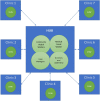Development, implementation, and evaluation of Teach Back curriculum for community health workers
- PMID: 36405583
- PMCID: PMC9669070
- DOI: 10.3389/fmed.2022.918686
Development, implementation, and evaluation of Teach Back curriculum for community health workers
Abstract
Teach Back is a commonly used communication method to improve patient understanding and retention of health information. The method has been shown to be effective in improving patient and healthcare system outcomes, including patient health literacy and hospital readmissions. Community health workers (CHWs) are frontline healthcare workers who can help address patient health and social needs associated with hospital readmissions. However, a gap exists in Teach Back curricula and training methods reflecting the scope of work for CHWs. The objective of this training was to provide CHWs with didactic information and skill building practice curriculum focused on the integration of Teach Back into clinical patient interactions, care coordination, and follow-up support. A multidisciplinary team of academic and clinical partners at a large academic health university developed, implemented, and evaluated a 3-week pilot Teach Back training with CHWs through a quality improvement approach. The CHWs reported overall satisfaction with the training and instructors. The academic clinical partnership allowed the training to be tailored to the daily clinical workflow as reflected in the CHWs agreement that the training was relevant and practical. With the repeated exposure to Teach Back each week, the CHWs also reported an increase in confidence and conviction in using Teach Back. Additional implementation and evaluation of the training curriculum for CHWs is needed to gain further insights into Teach Back and training best practices and translation into practice.
Keywords: Teach Back; community health worker; curriculum development; health literacy; training.
Copyright © 2022 Holcomb, Ferguson, Thornton and Highfield.
Conflict of interest statement
The authors declare that the research was conducted in the absence of any commercial or financial relationships that could be construed as a potential conflict of interest.
Figures
Similar articles
-
Development of Training Curriculum to Improve Patient Communication Skills and Social Support Among Community Health Workers.Health Lit Res Pract. 2022 Apr;6(2):e142-e150. doi: 10.3928/24748307-20220518-02. Epub 2022 Jun 6. Health Lit Res Pract. 2022. PMID: 35680123 Free PMC article.
-
Innovating a Teach-Back Model for Community Health Workers Led Health Literacy Practice to Improve COVID-19 Health Equity.Health Lit Res Pract. 2025 Apr;9(2):e56-e63. doi: 10.3928/24748307-20241127-01. Epub 2025 Apr 4. Health Lit Res Pract. 2025. PMID: 40194526 Free PMC article.
-
Workforce Readiness Training: A Comprehensive Training Model That Equips Community Health Workers to Work at the Top of Their Practice and Profession.Front Public Health. 2021 Jun 8;9:673208. doi: 10.3389/fpubh.2021.673208. eCollection 2021. Front Public Health. 2021. PMID: 34169058 Free PMC article.
-
Community health workers: improving population health through integration into healthcare systems.Curr Opin Pediatr. 2020 Oct;32(5):674-682. doi: 10.1097/MOP.0000000000000940. Curr Opin Pediatr. 2020. PMID: 32889962 Review.
-
Acknowledging the Role of Community Health Workers in Providing Essential Healthcare Services in Rural India-A Review.Cureus. 2022 Sep 20;14(9):e29372. doi: 10.7759/cureus.29372. eCollection 2022 Sep. Cureus. 2022. PMID: 36304347 Free PMC article. Review.
Cited by
-
Categorizing Extremely Positive Five-Star Online Reviews for Orthopedic Foot and Ankle Surgeons: A Retrospective Study.Cureus. 2024 Oct 20;16(10):e71932. doi: 10.7759/cureus.71932. eCollection 2024 Oct. Cureus. 2024. PMID: 39564028 Free PMC article.
-
Equity in Cancer and Chronic Disease Prevention through a Multi-Pronged Network Intervention: Works-in-Progress.Int J Environ Res Public Health. 2024 Feb 12;21(2):213. doi: 10.3390/ijerph21020213. Int J Environ Res Public Health. 2024. PMID: 38397702 Free PMC article.
-
Competency-based education and training for Community Health Workers: a scoping review.BMC Health Serv Res. 2025 Feb 17;25(1):263. doi: 10.1186/s12913-025-12217-7. BMC Health Serv Res. 2025. PMID: 39962470 Free PMC article.
References
LinkOut - more resources
Full Text Sources
Miscellaneous


